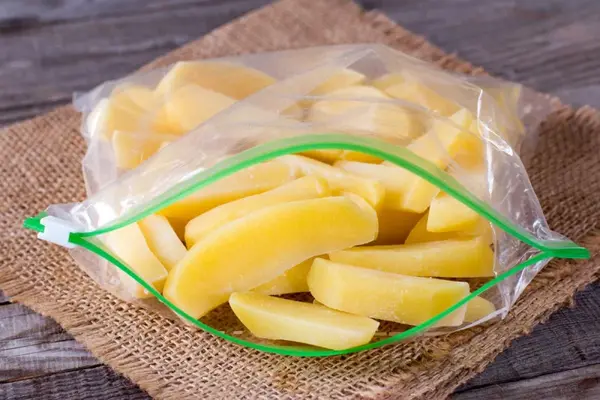Potatoes are a staple in many kitchens, but they can quickly spoil if not used in time. Freezing potatoes is an excellent way to preserve them for future use. Whether you’re looking to freeze raw potatoes, mashed potatoes, or cooked potatoes, this guide will walk you through the different methods to ensure your potatoes stay flavorful and convenient to use later.
Why Freeze Potatoes?
Freezing potatoes offers several benefits:
- Extend Shelf Life: Fresh potatoes typically last only a few weeks, but frozen potatoes can last for months in the freezer.
- Reduce Waste: If you have a surplus of potatoes, freezing them prevents spoilage and waste.
- Time-Saving: Having prepped or cooked potatoes on hand makes preparing meals faster and easier.
How to Freeze Whole Potatoes
While freezing whole potatoes is possible, it’s not the most ideal method because they can become mushy when thawed. However, if you prefer to freeze them whole, here’s how to do it:
- Wash and Scrub:
- Rinse the potatoes thoroughly to remove any dirt and debris. Scrub the skin if necessary.
- Blanch the Potatoes:
- Boil a large pot of water and add the potatoes.
- Boil small potatoes for 10 minutes and larger potatoes for 15 minutes.
- Blanching helps preserve their texture, flavor, and nutrients.
- Cool in Ice Water:
- After blanching, transfer the potatoes to a bowl of ice water to stop the cooking process. Let them sit for the same amount of time they were boiled.
- Dry and Wrap:
- Pat the potatoes dry with a clean towel, then wrap each potato in plastic wrap or foil.
- Store in Freezer Bags:
- Place the wrapped potatoes in a resealable freezer bag. Squeeze out excess air and seal tightly.
- Label and Freeze:
- Write the date on the bag, then place the potatoes in the freezer. They can be stored for up to 12 months.
How to Freeze Mashed Potatoes
Freezing mashed potatoes is a great way to preserve leftover potatoes or make ahead for future meals. Here’s how to do it:
- Prepare Mashed Potatoes:
- Make your mashed potatoes as usual, including adding butter, cream, or any other seasonings you like. Avoid adding too much liquid, as this can cause the mashed potatoes to become watery when thawed.
- Cool Completely:
- Allow the mashed potatoes to cool completely before freezing. This prevents condensation and ice crystals from forming inside the storage container.
- Portion and Pack:
- Divide the mashed potatoes into meal-sized portions for easier use.
- Place them in an airtight container or freezer bag, removing as much air as possible to prevent freezer burn.
- Label and Freeze:
- Write the date on the container or bag and place it in the freezer. Mashed potatoes can last for up to 10 months in the freezer.
To use, thaw in the refrigerator overnight or reheat in the microwave.
How to Freeze Sliced, Diced, or Cubed Potatoes
Freezing sliced or diced potatoes is an efficient method for quick use in recipes like fries, hashbrowns, or stews. Here’s how to do it:
- Peel (Optional) and Cut the Potatoes:
- Peel the potatoes if desired, then slice, dice, or cube them to your preferred size.
- Blanch the Potatoes:
- Boil a large pot of water, and add the cut potatoes.
- Blanch the potato slices or cubes for 3-5 minutes (for smaller pieces).
- Larger pieces or whole potatoes should be boiled for about 10-15 minutes.
- Cool in Ice Water:
- Transfer the blanched potatoes to a bowl of ice water for the same amount of time they were boiled to stop the cooking process.
- Drain and Dry:
- Drain the potatoes and pat them dry to remove excess moisture.
- Pre-Freeze (Optional):
- Spread the potato pieces in a single layer on a baking sheet. Freeze for about 1-2 hours to prevent clumping.
- Store in Freezer Bags:
- Transfer the potatoes to freezer bags or airtight containers. Label with the date, and store in the freezer for up to 12 months.
Frozen potato cubes or slices can be used directly from the freezer in dishes like soups, casseroles, or stir-fries.
How to Freeze French Fries
Homemade French fries are a great option for freezing. Here’s how to freeze fries for later use:
- Peel (Optional) and Cut Potatoes into Fries:
- Peel the potatoes (if desired), then slice them into thin strips, about 1/4 inch thick.
- Blanch the Fries:
- Bring a pot of water to a boil, and blanch the fries for 3-5 minutes. This step helps preserve the texture and flavor.
- Cool in Ice Water:
- After blanching, transfer the fries to a bowl of ice water for 3-5 minutes to cool them down.
- Drain and Dry:
- Drain the fries and pat them dry with a towel.
- Pre-Freeze (Optional):
- Spread the fries out on a baking sheet and freeze for 1-2 hours.
- Store in Freezer Bags:
- Transfer the frozen fries into a resealable freezer bag. Label with the date, then store them in the freezer.
Frozen fries can last up to 12 months and can be baked or fried directly from frozen.
How to Freeze Potato Wedges
Potato wedges can be prepped and frozen for an easy, quick side dish. Here’s how:
- Cut the Potatoes into Wedges:
- Slice the potatoes into wedges, leaving the skin on for added texture.
- Blanch the Wedges:
- Boil the potato wedges for 3-5 minutes, then transfer them to ice water to stop the cooking process.
- Pre-Freeze:
- Spread the wedges in a single layer on a baking sheet and freeze for 1-2 hours.
- Store in Freezer Bags:
- Once frozen, transfer the wedges into freezer bags or containers. Label and date them, then store them in the freezer.
Frozen potato wedges can last up to 12 months and can be baked directly from the freezer.
Tips for Freezing Potatoes
- Blanching is Essential:
- Blanching potatoes before freezing helps preserve their texture, color, and flavor. Skipping this step can result in mushy potatoes after thawing.
- Avoid Excess Water:
- After blanching, always dry the potatoes thoroughly before freezing to avoid ice crystals and freezer burn.
- Freezing in Portions:
- To make it easier to use only what you need, consider freezing potatoes in smaller portions or individual serving sizes.
- Label and Date:
- Always label freezer bags or containers with the date to keep track of their storage time.
How to Use Frozen Potatoes
Frozen potatoes can be used in many ways, including:
- Mashed potatoes: Thaw and reheat them.
- Fried potatoes: Bake, fry, or roast from frozen.
- Hashbrowns: Simply shred and cook.
- Soups and stews: Add frozen potatoes directly to your recipe.










